Folk Culture
Regional Dialect
The local dialects in Shanxi are quite diverse, and mainly divided into two categories: Jin dialect and Zhongyuan Mandarin. Among them, the Jin dialect is the main component of Shanxi dialects. The Jin dialect is significant for Chinese poetry in the Tang Dynasty and retains many phonetic characteristics of ancient Chinese. This makes the Shanxi dialect distinct from other dialects in pronunciation, as some words may have older or unique pronunciations in the Shanxi dialect. Therefore, it is easier for Shanxi people to learn ancient Chinese. Shanxi dialects are geographically divided into six areas: central dialect, western dialect, southeastern dialect, northern dialect, southwestern dialect, and northeastern dialect, each with its unique dialect.
Food Culture
Shanxi people have a fondness for noodles, and they often have at least one meal of noodles a day, which mainly consists of various types of noodles and pasta. The noodles can be sliced, pinched, rolled, pressed, twirled, or scraped, each with its unique shape. Shanxi cuisine also cannot be separated from vinegar. Shanxi people always use vinegar as a seasoning, regardless of what they are eating. Since Shanxi cuisine often consists of high-calorie foods, vinegar, which helps with digestion, is an essential part of the Shanxi diet. Shanxi is also renowned for its fine liquor - Fenjiu. This traditional Chinese liquor is famous for its unique brewing process and taste. As a representative of the light aroma-type Baijiu, Fenjiu is rich and mellow in body, smooth and velvety in taste, offering a taste of thousands of years of history and culture with every sip.
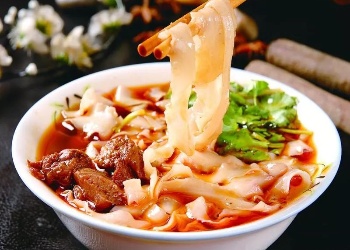
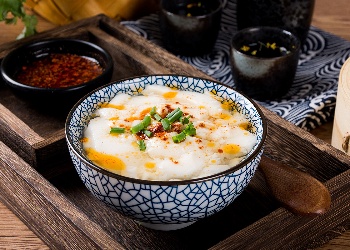
Sliced Noodles Tofu Pudding
Shanxi specialty snacks include: stuffed intestines, Babing cakes, Wantuo (a kind of pasta ), buckwheat noodles, tofu pudding, Xiaoyi-fired cakes, and Shouyang tofu jerky.
Shanxi specialty noodles include: sliced noodles pointed noodles, Camian noodles, Jiupianzi noodles, Helou noodles, fish-shaped noodles, cat ear-shaped noodles, bra, zhanpianzi.
Traditional Drama
Jin opera
Shanxi traditional operas are vibrant and diverse, with unique characteristics, and are a significant component of Chinese opera art. Among them, the four major Bangzi operas of Shanxi - Pu Opera (蒲剧), Jin Opera (晋剧), North Road Bangzi (北路梆子), and Shangdang Bangzi (上党梆子) - are known as the four pillars of Shanxi opera. They share the same roots but have different branches, inheriting the authentic charm of the Bangzi cavity. Jin Opera, also known as Shanxi Bangzi or Middle Road Opera, is one of the most representative types of Shanxi opera. Its singing structure belongs to the plate cavity system, including various singing forms such as Luantan (乱弹), Qiang’er (腔儿), and Quzi (曲子), with unique musical charm. The performance style of Jin Opera is a blend of roughness and delicacy, able to present both heroic historical stories and graceful and healthy folk life.
Pu Opera, also known as Puzhou Bangzi, originated in ancient Puzhou (today’s Yongji) and is one of the oldest types of opera among the four major bangzi operas in Shanxi. North Road Bangzi and Shangdang Bangzi are also important representatives of Shanxi opera. North Road Bangzi is popular in the northern part of Shanxi and some areas of Inner Mongolia and Hebei, with a passionate and exciting sound cavity. Shangdang Bangzi originated in the ancient Shangdang Prefecture and was formed by the integration of Luo Luo Opera (罗罗戏), Juan Opera (卷戏), and local folk melodies introduced from other places during the Ming and Qing Dynasties, exhibiting a strong local flavor. They each have their unique characteristics and jointly constitute the rich and colorful art of Shanxi opera. These traditional operas not only possess profound artistic value but also carry the historical memories and cultural traditions of the people of Shanxi, making them treasures in the treasury of Chinese opera.
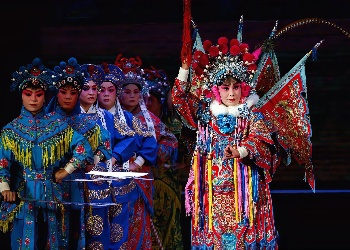
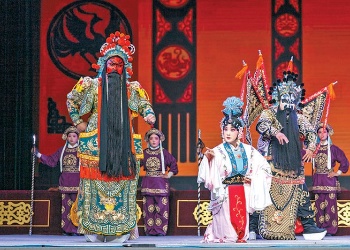
Jin Opera Pu Opera
Traditional repertoire:
Jin Opera is rich in traditional plays, with more than 200 frequently staged, including Weishui River, Beating the Golden Branch, Lintong Mountain, Qiankun Belt, Shatuo Country, War of Wan City, White Water Beach, Jinshui Bridge, Flame Pony, Fan Palace, Double Lock Mountain and so on. Each play has its own unique characteristics.
Traditional Music
Mount Wutai Buddha Music
Mount Wutai Buddhist Music, a traditional music popular in the area of Mount Wutai in Wutai County, Shanxi Province, is renowned as one of the national-level intangible cultural heritages. This musical form flourished with the introduction of Buddhism in Shanxi and drew musical nourishment from Tang and Song dynasty melodies, Yuan dynasty zaju songs, folk songs, and folk instrumental music, evolving into temple music with distinct Chinese national characteristics. Mount Wutai Buddhist Music is a product of the integration of musical art and religion and is considered a representative of northern Buddhist music. Mount Wutai Buddhist Music mainly consists of two categories: Han Chuan (Qingmiao) music and Tibetan Chuan (Huangmiao) music. Both Qingmiao music and Huangmiao music include two forms: vocal music and instrumental music. Vocal music involves the singing of various sutras during religious rites, mainly in four forms: harmonious chanting, chanting commands, chanting sutras, and chanting straight numbers. Mount Wutai Buddhist Music is a musical form with deep historical and cultural connotations. It is not only a significant component of the Buddhist culture of Mount Wutai but also a treasure of traditional Chinese music culture.
Inheritance significance:
As a representative of Northern Buddhist music, Mount Wutai Buddhist Music possesses strong regional characteristics and ethnic style. Through the inheritance of Mount Wutai Buddhist Music, we can further promote the dissemination and development of Buddhist culture, and deepen people's understanding and respect for Buddhism. In addition, inheriting Mount Wutai Buddhist Music helps to protect and inherit China's intangible cultural heritage. As one of the national-level intangible cultural heritages, Mount Wutai Buddhist Music carries rich historical information and cultural connotations. Through its inheritance and protection, we can ensure that this cultural treasure continues to be passed down and developed, leaving precious cultural heritage for future generations.
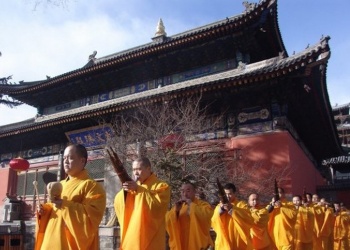
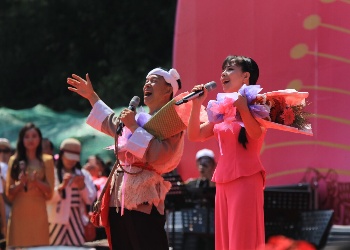
Mount Wutai Buddha Music Zuoquan Blossom Tune
Zuoquan Blossom Tune
Zuoquan Blossom tune is a form of Han folk song popular in the Taihang Mountains of Shanxi Province, and it is one of the national-level intangible cultural heritages. Most of the Zuoquan Blossom tunes are love songs, with short and lively melodies and beautiful tunes. They are usually composed of two musical phrases that echo each other, and this musical structure makes the songs more expressive and tense in portraying emotional ups and downs. Meanwhile, the lyrics of the flowering tunes are full of life and sincere emotions, whether describing mountain labor, rural scenery, or expressing love and family ties, they all appear so natural and touching. Nowadays, the Zuoquan Blossom tune has become a cultural calling card for Zuoquan County and even the whole Shanxi Province. It is not only widely circulated locally, but also attracts more and more tourists to come and listen to and appreciate it. At the same time, to better inherit and develop the Zuoquan Blossom tune, the local government and cultural departments have also taken a series of measures, such as holding the flowering tune cultural festival, carrying out relevant training and competitions, so that this traditional art form can be better inherited and carried forward.
Traditional Dance
Yicheng Flower Drum
Yicheng Flower Drum is a traditional dance art in Yicheng County, Shanxi Province, with profound historical and cultural heritage and unique artistic features. The performance form of Yicheng Flower Drum is rich and colorful, with a lively and bright rhythm and magnificent momentum. Through various ways of running formations, playing flower drums, and singing, the performance shows its rough and enthusiastic style. In addition, different positions of the drums, such as High Drums, Middle Drums, and Low Drums, also increase the diversity and appreciation of the performance. Moreover, Yicheng Flower Drum has various forms of performance, including venue performances and square performances, which are suitable for parade performances in festival celebrations and centralized displays on the square.
Yicheng Flower Drum has a long history. According to historical records, it has existed since the Zhenguan period of the Tang Dynasty, reached its peak in the Ming Dynasty, and had clear records in the Qing Dynasty. This traditional art form is not only widely circulated locally, but also was included in the first batch of national intangible cultural heritage lists approved by the State Council in 2006, making Yicheng County known as the "Hometown of Chinese Flower Drum." The inheritance and development of Yicheng Flower Drum cannot be separated from the efforts of generations of flower drum artists. Through exquisite skills and unremitting inheritance, they have enabled this art form to continue to this day. Nowadays, the Yicheng Flower Drum has become an important part of local culture, not only playing a significant role in festival celebrations but also becoming a business card showing the charm of Yicheng culture.
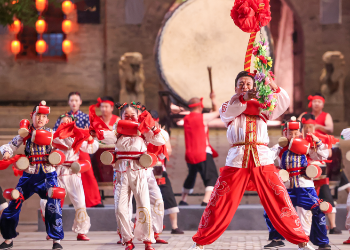
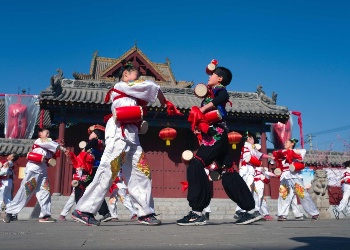
Traditional Skills
Fenjiu brewing technique
Shanxi Fenjiu, as a traditional famous liquor in China, is renowned for its long history and unique brewing techniques. Produced in Xinghua Village, Fenyang City, Shanxi Province, it is also known as “Xinghua Village Liquor”. The history of Fenjiu can be traced back to 4,000 years ago, making it one of the birthplaces of ancient brewing in China. During the Northern and Southern Dynasties, Fenjiu had already become a royal liquor in the palace and was highly praised by Emperor Wucheng of the Northern Qi Dynasty. It was hailed as the earliest national liquor and a national treasure.
The brewing techniques of Fenjiu are unique, and it is crafted through six main processes: grinding, wetting, steaming, fermentation, distillation, and storage. This technique has been listed as a national-level intangible cultural heritage, reflecting the wisdom and labor achievements of the ancient Chinese working people. As a typical representative of Qingxiang-style Baijiu, Fenjiu is renowned for its smooth taste at the beginning, sweet aftertaste, lingering aroma after drinking, and long-lasting finish. It enjoys high popularity, reputation, and loyalty among consumers both at home and abroad.
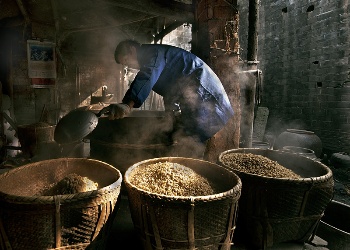
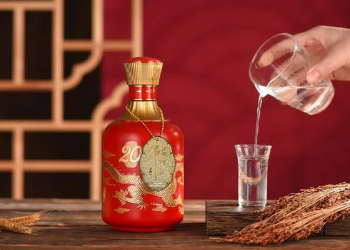
Fenjiu brewing process Picture of Fenjiu
Mature vinegar brewing skills
Shanxi Mature vinegar, aspecialty of Shanxi Province and a product with China's national geographical indication has a history of more than 3,000 years and is known as "the best vinegar in the world." It is renowned for its five major characteristics of color, aroma, mellowness, richness, and sourness, and is one of the four famous vinegars in China. Shanxi aged vinegar is mainly brewed from high-quality sorghum, barley, peas, and other grains through steaming, fermentation, smoking, dripping, and drying. It has a sauce-red color and tastes soft, sour, fragrant, sweet, and fresh. It contains up to 18 kinds of free amino acids, eight of which are essential for the human body. It also contains various vitamins and has the effects of promoting gastric juice secretion, inhibiting blood sugar elevation, and reducing blood lipids.
The brewing technology of Shanxi-aged vinegar is unique, and the most distinctive one is the smoking fermentation process, which originated in Shanxi and gives the vinegar a unique aroma. In addition, various processes such as low-temperature liquid fermentation of lees, high-temperature inoculation, and ignition, and the combination of smoking and vinegar dripping are also used in the brewing process, allowing the vinegar to undergo complex biochemical reactions during aging, thus achieving the excellent qualities of softness, sourness, fragrance, sweetness, and freshness. In daily life, Shanxi aged vinegar is not only an excellent choice for cooking, adding unique flavors to dishes, but also widely used in traditional Chinese medical diet therapy. For example, drinking a small glass of vinegar can eliminate hiccups, constipation patients can drink water mixed with vinegar daily to lubricate the intestines and relieve constipation, and applying vinegar to the bitten areas by mosquitoes can reduce itching, pain, and swelling.
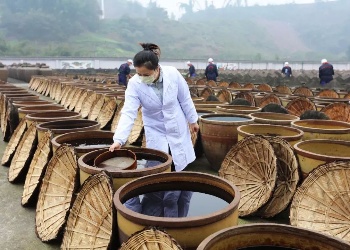
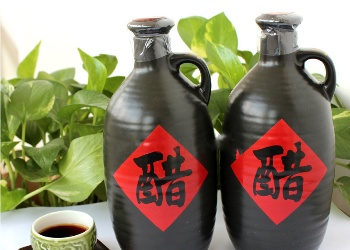
Mature vinegar brewing process Picture of Mature vinegar




































